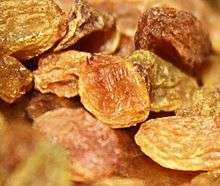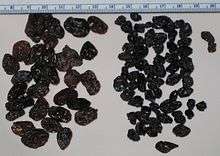Raisin



A raisin is a dried grape. Raisins are produced in many regions of the world and may be eaten raw or used in cooking, baking, and brewing. In the United Kingdom, Ireland, New Zealand, and Australia, the word "raisin" is reserved for the dark-coloured dried large grape,[1] with "sultana" being a golden-coloured dried grape, and "currant" being a dried small Black Corinth seedless[2] grape.[3]
Etymology
The word "raisin" dates back to Middle English and is a loanword from Old French; in modern French, raisin means "grape", while a dried grape is a raisin sec, or "dry grape". The Old French word, in turn, developed from the Latin word racemus, "a bunch of grapes".[4]
Varieties

Raisin varieties depend on the type of grape used, and are made in a variety of sizes and colors including green, black, brown, blue, purple, and yellow. Seedless varieties include the sultana (the common American type is known as Thompson Seedless in the USA), the Greek currants (black corinthian raisins, Vitis vinifera L. var. Apyrena)[2] and Flame grapes. Raisins are traditionally sun-dried, but may also be water-dipped and artificially dehydrated.
"Golden raisins" are treated with sulfur dioxide after drying to give them their golden color.
Black Corinth or Zante currant are miniature, sometimes seedless[2] raisins that are much darker and have a tart, tangy flavor. They are often called currants. Muscat raisins are large compared to other varieties, and also sweeter.
Several varieties of raisins produced in Asia are available in the West only at ethnic grocers. Monukka grapes are used for some of these.
Nutrition

| Nutritional value per 100 g (3.5 oz) | |
|---|---|
| Energy | 1,252 kJ (299 kcal) |
|
79.18 g | |
| Sugars | 59.19 g |
| Dietary fiber | 3.7 g |
|
0.46 g | |
|
3.07 g | |
| Vitamins | |
| Thiamine (B1) |
(9%) 0.106 mg |
| Riboflavin (B2) |
(10%) 0.125 mg |
| Niacin (B3) |
(5%) 0.766 mg |
| Pantothenic acid (B5) |
(2%) 0.095 mg |
| Vitamin B6 |
(13%) 0.174 mg |
| Folate (B9) |
(1%) 5 μg |
| Choline |
(2%) 11.1 mg |
| Vitamin C |
(3%) 2.3 mg |
| Vitamin E |
(1%) 0.12 mg |
| Vitamin K |
(3%) 3.5 μg |
| Minerals | |
| Calcium |
(5%) 50 mg |
| Iron |
(14%) 1.88 mg |
| Magnesium |
(9%) 32 mg |
| Manganese |
(14%) 0.299 mg |
| Phosphorus |
(14%) 101 mg |
| Potassium |
(16%) 749 mg |
| Sodium |
(1%) 11 mg |
| Zinc |
(2%) 0.22 mg |
| Other constituents | |
| Fluoride | 233.9 µg |
|
| |
| |
|
Percentages are roughly approximated using US recommendations for adults. Source: USDA Nutrient Database | |
Raisins can contain up to 72% sugars by weight,[5] most of which is fructose and glucose. They also contain about 3% protein and 3.7%–6.8% dietary fiber.[6] Raisins, like prunes and apricots, are also high in certain antioxidants, but have a lower vitamin C content than fresh grapes. Raisins are low in sodium and contain no cholesterol.[7]
Data presented at the American College of Cardiology's 61st Annual Scientific Session in 2012 suggest that, among individuals with mild increases in blood pressure, the routine consumption of raisins (three times a day) may significantly lower blood pressure, especially when compared to eating other common snacks.[8]
Toxicity in pets
Raisins can cause renal failure in dogs. The cause of this is not known.[9]
Sugars
Raisins are sweet due to their high concentration of sugars (about 30% fructose and 28% glucose by weight). The sugars can crystallise inside the fruit when stored after a long period, making the dry raisins gritty, but that does not affect their usability. These sugar grains can be dissolved by blanching the fruit in hot water or other liquids.
Grades of raisins in the U.S.
- Grade A
- The color is good, and the flavor is characteristic of raisins. These raisins show development characteristics indicative of the fact that they are prepared from well-matured grapes (containing no less than 80% water by weight). The processed raisins contain less than 19% moisture by weight.[10]
- Grade B
- The color and flavor is reasonably good. These raisins show development characteristics that highlight the fact that the raisins were prepared from reasonably well-matured grapes containing at least 70% water by weight. These raisins also contain less than 19% moisture, by weight.[10]
- Grade C
- The color and flavor are fairly good. These raisins show development characteristics of raisins prepared from fairly well-matured grapes containing at least 55% water by weight. These raisins also contain less than 19% moisture, by weight.[10]
- Substandard
- Raisins that fail to meet the standards of grade C.
Raisin production
Raisins are produced commercially by drying harvested grape berries. For a grape berry to dry, water inside the grape must be removed completely from the interior of the cells onto the surface of the grape where the water droplets can evaporate.[11] However, this diffusion process is very difficult because the grape skin contains wax in its cuticle, which prevents the water from passing through.[11] In addition to this, the physical and chemical mechanisms located on the outer layers of the grape are adapted to prevent water loss.[12]
The three steps to commercial raisin production include pre-treatment, drying, and post-drying processes.[11]
Pre-treatment
Pre-treatment is a necessary step in raisin production to ensure the increased rate of water removal during the drying process.[11] A faster water removal rate decreases the rate of browning and helps to produce more desirable raisins.[11] The historical method of completing this process was developed in the Mediterranean and Asia Minor areas by using a dry emulsion cold dip made of potassium carbonate and ethyl esters of fatty acids.[12] This dip was shown to increase the rate of water loss by two- to three-fold.[12] Recently, new methods have been developed such as exposing the grapes to oil emulsions or dilute alkaline solutions. These methods can encourage water transfer to the outer surface of grapes which helps to increase the efficiency of the drying process.[11]
Drying
The three types of drying methods are: sun drying, shade drying, and mechanical drying.[11] Sun drying is an inexpensive process; however, environmental contamination, insect infections, and microbial deterioration can occur and the resulting raisins are often of low quality. Additionally, sun drying is a very slow process and may not produce the most desirable raisins.[11] Mechanical drying can be done in a safer and more controlled environment where rapid drying is guaranteed. One type of mechanical drying is to use microwave heating. Water molecules in the grapes absorb microwave energy resulting in rapid evaporation. Microwave heating often produces puffy raisins.[11]
Post-drying processes
After the drying process is complete, raisins are sent to processing plants where they are cleaned with water to remove any foreign objects that may have become embedded during the drying process.[11] Stems and off-grade raisins are also removed. The washing process may cause rehydration, so another drying step is completed after washing to ensure that the added moisture has been removed.[11]
All steps in the production of raisins are very important in determining the quality of raisins. Sometimes, sulfur dioxide is applied to raisins after the pre treatment step and before drying to decrease the rate of browning caused by the reaction between polyphenol oxidase and phenolic compounds. Sulfur dioxide also helps to preserve flavour and prevent the loss of certain vitamins during the drying process.[12]
Nutrition and health
Raisins can be eaten as a nutritious snack, rich in dietary fiber, carbohydrates with a low glycemic index, minerals, vitamins, and other micronutrients. Their fat content is low. The overall nutritional value of raisins means they are recommended as a snack for both weight control and for maintaining good human health because they help the control of glucose, the good functioning of the digestive system and the regulation of blood pressure.[13] Replacing unhealthy snacks by raisins in usual and moderate quantity can improve health biomarkers in patients with controlled type 2 diabetes. Adoption of this dietary habit may reduce diastolic blood pressure and increase the levels of plasma antioxidants in type 2 diabetic patients.[14] Corinthian raisins are a moderate glycemic index fruit. They can be consumed in small amounts even by diabetic patients instead of sweets in a balanced diet.[15] Antioxidants in Greek raisins may reduce the risk for malignancies in the stomach and colon. Thus, in a balanced diet, their antioxidants can help maintain the health of the digestive system.[16]
See also
| Look up raisin in Wiktionary, the free dictionary. |
| Wikimedia Commons has media related to Raisin. |
| Wikisource has the text of the 1911 Encyclopædia Britannica article Raisin. |
- List of dried foods
- Snap-dragon (game), a Victorian parlour game that involved raisins being plucked from a bowl of burning brandy
- Sun-Maid, a popular brand of raisins available in North America and the United Kingdom
References
- ↑ Dom Costello. "Kew Gardens explanation". Kew.org. Retrieved 16 January 2013.
- 1 2 3 Chiou, Antonia; Panagopoulou, Eirini A.; Gatzali, Fotini; De Marchi, Stephania; Karathanos, Vaios T. (2014). "Anthocyanins content and antioxidant capacity of Corinthian currants (Vitis vinifera L., var. Apyrena)". Food Chemistry. 146: 157–65. doi:10.1016/j.foodchem.2013.09.062. PMID 24176327.
- ↑ The Oxford English Dictionary entry at "currant" = "raisins of Corauntz n." (also called "raisins of Corinth")
- ↑ Harper, Douglas. "raisin". Online Etymology Dictionary.
- ↑ Albert Julius Winkler. General viticulture, University of California Press, 1962, p. 645. ISBN 978-0-520-02591-2
- ↑ "USDA NDB Raisins". USDA. Retrieved 20 April 2013.
- ↑ "Nutrition Experts & Dietitians » California Raisins – The Wise Choice". Calraisins.org. 22 February 1999. Retrieved 16 January 2013.
- ↑ Bays, Harold E.; Schmitz, Kathy; Christian, Amber; Ritchey, Michelle; Anderson, James (2012). "Raisins And Blood Pressure: A Randomized, Controlled Trial". Journal of the American College of Cardiology. 59 (13): E1721. doi:10.1016/S0735-1097(12)61722-7. Lay summary – ScienceDaily (March 26, 2012).
- ↑ "Snopes.com:Raisins and grapes can be harmful to dogs". Retrieved 21 January 2011.
- 1 2 3 "United States Standards for Grades of Processed Raisins" (PDF). United States Department of Agriculture. 1 December 1978.
- 1 2 3 4 5 6 7 8 9 10 11 Esmaiili, M.; Sotudeh-Gharebagh, R.; Cronin, K.; Mousavi, M. A. E.; Rezazadeh, G. (2007). "Grape Drying: A Review". Food Reviews International. 23 (3): 257. doi:10.1080/87559120701418335.
- 1 2 3 4 Christensen, L.P., and Peacock, W.L. (20 April 2013) "The Raisin Drying Process". Raisin Production Manual, University of California.
- ↑ Kanellos, P. T.; Kaliora, A. C.; Gioxari, A.; Christopoulou, G. O.; Kalogeropoulos, N.; Karathanos, V. T. (2013). "Absorption and Bioavailability of Antioxidant Phytochemicals and Increase of Serum Oxidation Resistance in Healthy Subjects Following Supplementation with Raisins". Plant Foods for Human Nutrition. 68 (4): 411–5. doi:10.1007/s11130-013-0389-2. PMID 24114059.
- ↑ Kanellos, P.T.; Kaliora, A.C.; Tentolouris, N.K.; Argiana, V.; Perrea, D.; Kalogeropoulos, N.; Kountouri, A.M.; Karathanos, V.T. (2014). "A pilot, randomized controlled trial to examine the health outcomes of raisin consumption in patients with diabetes". Nutrition. 30 (3): 358–64. doi:10.1016/j.nut.2013.07.020. PMID 24262513.
- ↑ Kanellos, Panagiotis T.; Kaliora, Andriana C.; Liaskos, Christos; Tentolouris, Nikolaos K.; Perrea, Despina; Karathanos, Vaios T. (2013). "A Study of Glycemic Response to Corinthian Raisins in Healthy Subjects and in Type 2 Diabetes Mellitus Patients". Plant Foods for Human Nutrition. 68 (2): 145–8. doi:10.1007/s11130-013-0348-y. PMID 23564595.
- ↑ Kountouri, Aggeliki M.; Gioxari, Aristea; Karvela, Evangelia; Kaliora, Andriana C.; Karvelas, Michalis; Karathanos, Vaios T. (2013). "Chemopreventive properties of raisins originating from Greece in colon cancer cells". Food & Function. 4 (3): 366–72. doi:10.1039/c2fo30259d. PMID 23211994.
Further reading
- C. D. Wu; J. F. Rivero-Cruz; M. Zhu; B. Su; A. D. Kinghorn (2005). "Antimicrobial Phytochemicals in Thompson Seedless Raisins (Vitis vinifera L.) Inhibit Dental Plaque Bacteria". American Society for Microbiology meeting. 5–9 June. Atlanta.
